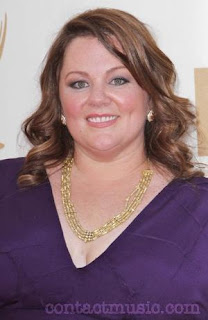It is beginning to look like the fashion industry is getting with it. Designers are looking at how they can make clothes that adjust to the wearer.
Many women know what it is like to have that perfect dress fit for a season and then realizing the next season that she may have put on or lost weight.
How many times have you taken the same piece to the tailor? Well, I'm not telling how much I have spent changing my clothes to fit me.
Finally some, at least, retailers and designers are looking at how to fix that. Read this Wall Street Journal Fashion piece from Sarah Nassauer below
Project Plus-Size
When Jennette Fulda shops for a dress, she doesn't think only about the color and style. She thinks about how long it will fit her.She lost 200 pounds between 2005 and 2008, dropping from a size 32 to 12. Then she gained enough to buy clothes in size 18 and 20. When her weight is changing, she doesn't want to "sink 100 bucks into one item," says the 30-year-old Web designer and author from Chapel Hill, N.C.
![[PLUSSIZE]](http://si.wsj.net/public/resources/images/PJ-BC501_PLUSSI_DV_20110831170231.jpg) Lane Bryant
Lane Bryant
PROBLEM: Many jeans leave women with a tummy bulge and a gap at the waistband in the back. SOLUTION: Lane Bryant's new $69.95 T3 jeans include a panel at the stomach and an elastic waist band.
The fashion industry is trying new tricks to win over shoppers like Ms. Fulda and address a perplexing gap: Although at least one-third of American women are plus-size, sales of plus-size clothing hover around 15% of women's apparel sales.
To address women's weight fluctuations and other challenges unique to the plus-size shopper, apparel makers are putting a new focus on fit. They are throwing out their old clothing patterns, turning to new slimming and smoothing technology and taking a new look at the psychology of their customers.
Lane Bryant, one of the largest sellers of plus-size clothing in the U.S., with about 900 stores, is working on bras that adapt to a body whose weight changes sharply, says a spokeswoman. "Our customer fluctuates in size. How do we help her there?" says Gill Heer, senior designer and director of intimate apparel for Lane Bryant.
![[PLUSSIZE]](http://si.wsj.net/public/resources/images/PJ-BC503_PLUSSI_DV_20110831163501.jpg) Anna Scholz
Anna Scholz
PROBLEM: It's hard to achieve a streamlined silhouette in dressy clothing without wearing serious shapewear. SOLUTION: Anna Scholz puts smoothing 'tricks' into her $372 Dynasty Pleat Shift Dress, such as a tight underlay of fabric to hold in the belly and a looser pleated outer layer.
Avenue, a plus-size retailer with 450 stores in the U.S., reworked the fit of all its clothes over the past two years to make sizing more consistent; shoppers don't want to have to try on several sizes each time they consider a new style of pants. Avenue, which is owned by French conglomerate PPR, also researched the way body shape differs in larger sizes, leading to changes in clothing patterns that made the hip and bust fuller. It introduced a new denim line earlier this month based on the work.
One reason for the sales gap in plus-size clothing is demographic. In the U.S., an overweight woman is more likely to be poor, the Centers for Disease Control and Prevention says.
Another factor: While most retailers consider anything over 14 a plus size, garment sizing can be deceptive, because women's clothing brands are constantly adjusting the sizes. A size 0 today would have been a size 8 in 1970, so more plus-sized women are wearing smaller-size clothes, says Ed Gribbin, president of Alvanon Inc., a clothing size and fit-consulting firm based in New York City. The average size-14 woman today has a bust of 44 inches, a waist of 38¼ inches and hips of 46 inches, he says.
One hindrance to plus-size shoppers—which retailers are just starting to address—is that shopping can be an emotionally complex experience. When a plus-sized customer goes to a mall, she realizes most clothes there won't fit her, and "that's a bummer," says Liz Muñoz, chief merchant at Torrid, a plus-size brand with trendy clothes aimed at 18- to 35-year-olds. "You are up against all those issues in her head," she says.
For years, many clothing makers took little interest in the market, dissuaded by the cost and difficulty of designing clothes in larger sizes. The industry traditionally offered plus-size shoppers low-priced items that tended to cover rather than flatter the body.
If a brand gets a woman's fit and fashion right, "that's a transformational moment," says Ms. Muñoz. "When you do that, you have her."
Getting the fit right, however, is a challenge. As bodies get bigger, they have a wider variety of shapes, industry executives say. "The more weight you carry, the more diverse the distribution of your weight," says Anna Scholz, a London-based plus-size designer who sells high-end clothes.
![[PLUSSIZE-JUMP]](http://si.wsj.net/public/resources/images/PJ-BC508_PLUSSI_DV_20110831164501.jpg) Hanes;
Hanes;
Hanes's 'Just My Size' line has found that women like their comfortable T-shirts to have a pattern. The company is expanding its line of graphic T-shirts.
Lane Bryant has been making 3-D scans of its customers' bodies since 2004—65,000 women in total. It uses the data to come up with new and better fits. The company learned that about 15% of its customers have a greater than 10-inch difference between their waist and hip, 70% had an 8- to 10-inch difference and 15% have a 4- to 6-inch difference, says Richard Zielinski, technical design director for the brand.
As a result, the company introduced color-coded Right Fit jeans that align with the three shape groups the company discovered. It says the jeans don't gap at the back of the waistband, a common complaint among plus-size shoppers.
The company also used the size information to create its T3 Tighter Tummy Technology jeans, which will be rolled out in stores next week. They use internal shapewear technology like tummy panels to smooth the stomach area. Over about six months, the company created 10 prototypes of the jean. These included an internal-girdle concept that was dropped because it seemed gimmicky and made women "look really bad," creating bulges where the girdle didn't squeeze, says Mr. Zielinski.
![[PLUSSIZE-JUMP]](http://si.wsj.net/public/resources/images/PJ-BC509_PLUSSI_DV_20110831163957.jpg) Torrid
Torrid
Designers at Torrid elongate the figure by adding details to the shoulder and the base of the hem, and they often use high waistlines that hit the narrowest part of the body.
Fabric choices can make a crucial difference to a design. "Spandex is God's gift to this industry," says Laurie Williams-Fleury, vice president of technical design for Charming Shoppes Inc., the company that owns Lane Bryant and other plus-size retailers like Fashion Bug and Catherines. Designers at Torrid consider four typical body types: round, curvy, bottom-heavy and straight. The goal is to make a garment look flattering on all four, says Ms. Muñoz.
The company has learned that customers like clothes that create an hourglass shape and elongate. Details along the base of a dress hem can draw the eyes downward, says Ms. Muñoz. Embellishments like ruffles or patterns along the shoulder and neckline draw the eye up, she says.
Waist lines are generally high, sitting around the smallest part of the body, she says. "Empire waists are a big part of what we do," she says.
Generally, Ms. Muñoz notes, dresses are big sellers, because they are an easy way to look "feminine and fashionable without sacrificing comfort."
Ms. Scholz, the U.K. designer, says her clothes often incorporate "tricks." One of her best-selling items, the $372 Dynasty Pleat Shift Dress, has a tighter layer of fabric underneath and a looser, pleated layer on top that smooths out bulges. The summer 2012 collection will included more dresses with the design, says Ms. Scholz, whose largest distributor is the website of Saks Fifth Avenue.
Getting the fit of pants right is a key challenge. In general, people have a lot of variety in the shape of the lower half of their body. Also, most people are loyal to stores where pants fit them best. Shoppers think, " 'at this store the pants fit me, I'll keep coming,' " says Kristen Gaskins, senior vice president and general merchandising manager for Ashley Stewart, a plus-size retailer with 187 shops in the U.S. The brand is considering a line of pants that include built-in shapewear, she says.
The challenges of selling pants don't end with the design process. At Lane Bryant, narrow-cut "skinny jeans" sell well, but are called "slim." "We don't use the word skinny anymore because it's a turn-off," says Mr. Zielinski. When interviewing applicants for his fit-technology team, he has an important question to ask them: "How can you relate to a curvy person?"


















![[PLUSSIZE]](http://si.wsj.net/public/resources/images/PJ-BC501_PLUSSI_DV_20110831170231.jpg)
![[PLUSSIZE]](http://si.wsj.net/public/resources/images/PJ-BC503_PLUSSI_DV_20110831163501.jpg)
![[PLUSSIZE-JUMP]](http://si.wsj.net/public/resources/images/PJ-BC508_PLUSSI_DV_20110831164501.jpg)
![[PLUSSIZE-JUMP]](http://si.wsj.net/public/resources/images/PJ-BC509_PLUSSI_DV_20110831163957.jpg)